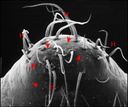Robber Spiders
Argyrodes
Classification
- Phylum: Arthropoda
- Subphylum: Chelicerata
- Class: Arachnida
- Order: Araneae
- Infraorder: Araneomorphae
- Family: Theridiidae
- Genus: Argyrodes
Pronunciation
How to pronounce Argyrodes: /ˌɑːr.d͡ʒɪˈroʊˌdiːz/
These audio files are automatically generated. While they are not always 100% accurate, they are a good starting point.
Images






Summary
Argyrodes, also known as dewdrop spiders, are small, kleptoparasitic comb-footed spiders known for their unique feeding strategies and commensal relationships with larger orb-weaver spiders' webs.
Physical Characteristics
Most species are relatively small, many are black with silvery markings. The body shape is characteristic, often conical or triangular, with a shorter third pair of legs. A. incursus has a body length of 3 to 4.5 millimetres, while A. fissifrons measures about 12 millimetres.
Identification Tips
Look for small spiders residing on the outskirts of webs built by larger orb-weaver spiders, often with silver markings that may attract larger prey.
Habitat
Primarily found in tropical and subtropical environments, often inhabiting the webs of other spiders.
Distribution
Worldwide distribution with a concentration in the tropics. Species are found in the United States, particularly A. elevatus in the southern US, A. nephilae in Florida, and A. pluto from Maryland to Missouri, extending to Mexico and Jamaica.
Diet
Kleptoparasitic, feeding on small prey items caught in the webs of host spiders. Some species also feed on the host spider itself.
Ecosystem Role
Argyrodes spiders play a role in ecosystem dynamics as kleptoparasites, influencing prey dynamics within the host webs, and can also affect host spider populations.
Evolution
The genus was first described by Eugène Louis Simon in 1864 and shows adaptations that enable kleptoparasitic behavior, influencing its evolutionary course.
Misconceptions
A common misconception is that Argyrodes frequently steal significant prey from host spiders; however, research shows they usually restrict themselves to smaller, unwanted prey items.
Tags
- Argyrodes
- spiders
- kleptoparasitic
- dewdrop spiders
- Theridiidae